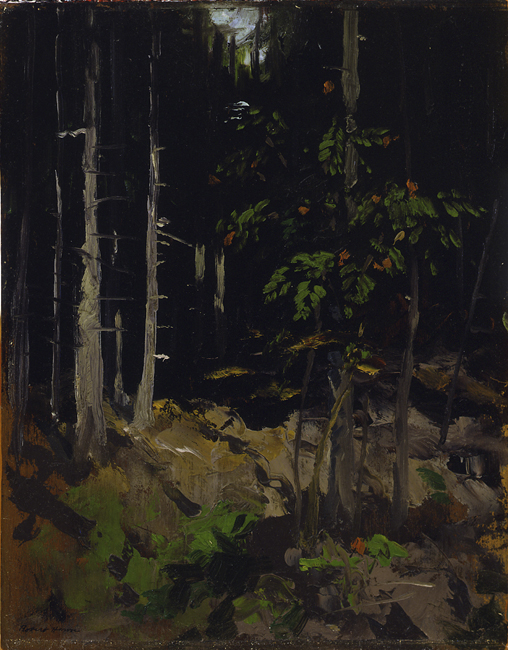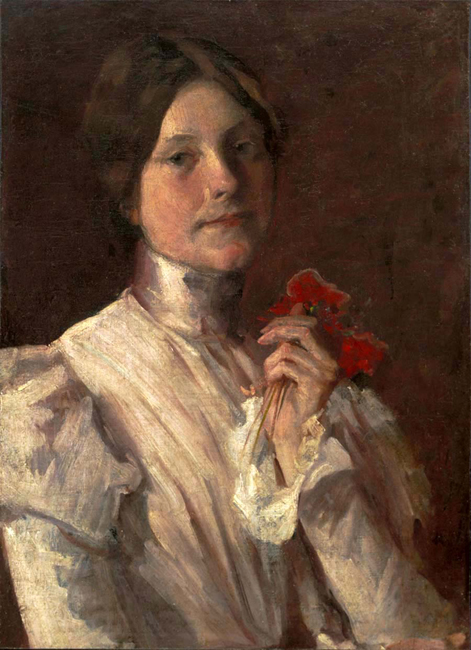The art world is no stranger to controversy. Recently, a number of major museums on both sides of the Atlantic have decided to postpone a major retrospective of the work of the American painter Philip Guston, citing the necessity for increased sensitivity around his work, much of which engages with thorny issues of racism, anti-Semitism, and the Holocaust. While I hope to write about Guston in this space in the future—he’s one of my favorite painters, and there are two works by him in the CFAM collection—today I turn instead to the early twentieth century, when a very different controversy rocked the New York art world. This controversy, which came to a head in November 1907, had everything to do with the rivalry between two of the country’s foremost artists: William Merritt Chase and Robert Henri.1
The 1907 controversy was about the future direction of the New York School of Art, which had been founded as the Chase School of Art in 1896 as a more progressive alternative to the Art Students League.2 Changing its name to the New York School of Art in 1898 when Chase turned over administration to others in order to focus on teaching, the school invited Robert Henri to teach there in 1902.3 Chase and Henri, two of the best-known and -regarded art teachers in the country, soon found themselves at odds over both the style and subject matter they would teach, a confrontation that resulted in Chase’s resignation from the school he had founded. Though their works share many common features, the differences are also striking. Chase was, in the words of one biographer, “a genteel bohemian,” whose studio in the famed Tenth Street Building was full of opulent and exotic furnishings, evidence of his taste and sophistication. He was well known for strolling around Manhattan with a liveried servant and Irish Wolfhound in tow.4 Henri, who was fifteen years younger, had a very different personal style. Emphasizing his rough-and-tumble Western origins, Henri was an adherent of the strenuous life, a belief that the supposed ills of urban modernity could be cured through vigorous physicality, a position also held by President Theodore Roosevelt, among others.5
These differences in personal style bled into the two men’s approaches to teaching. Chase was known for his painting demonstrations, bravura performances in which he quickly demonstrated his impeccable brushwork and free handling of color. He was also one of the first teachers to take female students, often using them as models for these demonstration pieces.6 Henri, meanwhile, cultivated an intense homosocial masculinity in his studios, encouraging wrestling and other forms of roughhousing—even including ritual hazing.7 Henri was also known as the leading figure of the Ashcan School, a loose conglomeration of painters—many of whom got their starts as commercial illustrators—in Philadelphia and then New York. Under Henri’s influence these artists, whose number included John Sloan, William Glackens, and George Bellows, turned from the refined subject matter preferred by Chase to the raw stuff of everyday life in New York’s streets and tenement buildings.8
Oil on canvas, 24 x 17 3/4 in., Gift of Gertrude Lundberg Richards, 1967.19
Right / Robert Henri (American, 1865-1929) Mountain Ash, Dark Woods, 1911, Oil on panel
15 x 11 3/8 in., Gift of Samuel B. and Marion W. Lawrence, 1991.10
Two works in CFAM’s American collection bear out these differences. Young Woman with Red Flowers, a 1904 portrait by Chase, was executed as a demonstration piece at the New York School of Art. The young woman—who gazes straight out of the picture plane in direct acknowledgement of the viewer’s presence—is a fine example of Chase’s facility with the brush. Her face is framed by her high, starched collar, while the red flowers she holds help to draw out the red and pink hues in her skin while also unifying her with the brownish-red of the background. Henri’s Mountain Ash, Dark Woods at first seems an odd subject for the man who formulated the urban realism of the Ashcan School. Painted during a trip to the deep woods of Maine, however, it reveals Henri’s devotion to the rugged outdoor life, far from the refined studio interior of Chase’s picture. It also demonstrates the sketchy style he encouraged in his students and emphasized in his own painting. This sketchiness, he believed, brought the painting closer to the realm of immediate experience, a way of investing its very surface with the authenticity he craved.9
Henri would
go on to take a key role in the 1913 International Exhibition of Modern
Art—known popularly as the Armory Show—which introduced the most recent
advances in European modernism to large American audiences for the first time.
Though many Americans were shocked by works like Marcel Duchamp’s Nude
Descending a Staircase, No. 2 (1912, Philadelphia Museum of Art), which
Henri helped select for the show, cubism and other abstract idioms would come
to have a profound impact on many American artists.10
This impact, and the increasing prevalence of abstraction during the twentieth
century, has served to somewhat obscure the very real stakes of the controversy
of 1907, which was all about the proper direction for modern art.
1 Kimberly Orcutt and Bruce Museum (Greenwich (Conn.)), Painterly Controversy: William Merritt Chase and Robert Henri : [Exhibition Held at the Bruce Museum, Greenwich, Conn., Jan. 27-Apr. 29, 2007 (Greenwich, Conn.: Bruce Museum, 2007), 16–17.
2 Interestingly, the school survives to this day as the Parsons School of Design, part of the New School.
3 Orcutt and Bruce Museum (Greenwich (Conn.)), Painterly Controversy, 32.
4 Orcutt and Bruce Museum (Greenwich (Conn.)), 21–22.
5 Orcutt and Bruce Museum (Greenwich (Conn.)), 22–23.
6 Keith L Bryant, William Merritt Chase, a Genteel Bohemian (Columbia: University of Missouri Press, 1991), 53–55, 186. Another favorite subject for the demonstrations was fish, which has resulted in fish still-lifes making up a large portion of the artist’s surviving oeuvre.
7 Orcutt and Bruce Museum (Greenwich (Conn.)), Painterly Controversy, 29–30.
8 For a definitive overview of the Ashcan School, see Rebecca Zurier, Picturing the City Urban Vision and the Ashcan School (Berkeley, CA: University of California Press, 2014).
9 Zurier, 119–23.
10 Peter John Brownlee et al., eds., The Eight and American Modernisms (Chicago: Distributed by the University of Chicago Press, 2009), 56–58.



